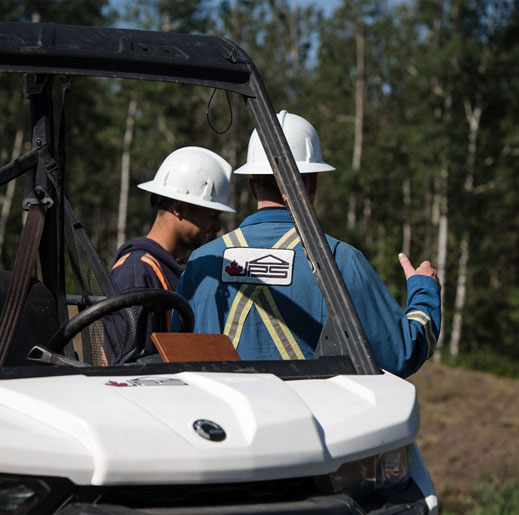We use diverse erosion control products to reduce erosion by managing surface water flow and capturing sediment. Our team has successfully implemented these measures across Alberta and in all seasons.
Silt Fence & Bags
Erosion Control Blankets
Straw Wattles
Gabion Baskets
Coconut Matting
Biodegradable Options
Water Diversion Berms
Check & Coffer Dams
When is erosion control most useful?
- Ensuring structural integrity: Construction projects may disrupt the natural landscape, making it more susceptible to erosion. Implementing erosion control techniques can help maintain the stability of structures and prevent land loss or damage.
- Protecting water bodies: Erosion can cause sediment and contaminants to enter nearby water sources, potentially harming aquatic life and affecting water quality. By employing erosion control measures, we can prevent pollutants from entering water bodies, thereby preserving their unique ecosystems.
- Safeguarding against natural elements: Erosion control products are essential for mitigating the impact of natural elements, such as wind and water, on the landscape. They can help prevent soil displacement, reduce the risk of landslides, and maintain the overall ecological balance.
- Preserving habitats: Wildlife habitats can be disrupted by erosion, leading to a loss of biodiversity. Implementing erosion control techniques can help protect these habitats and ensure the continued existence of native species.
In summary, erosion control is most useful when it comes to maintaining the structural integrity of construction projects, protecting water sources from contamination, mitigating the impact of natural elements on the landscape, and preserving wildlife habitats.
How does erosion control mitigate environmental impacts?
Negative impacts of sedimentation and runoff: In Alberta, all water runoff, whether from construction sites or riverbanks, eventually reaches a water body. This runoff can carry contaminants that adversely affect the local environment. Even minor alterations to a water body’s biochemistry can cause lasting harm to the habitats of native plants and animals. The most prevalent carriers of these contaminants are soils displaced by water or wind erosion.
How erosion controls prevent negative impacts: Erosion and Sediment Controls (ESC) help protect ground cover from elements like wind and water by securing materials in place and providing a protective barrier. When installed correctly, erosion control products effectively prevent soil loss and surface erosion while allowing surface water to drain naturally.
By employing ESC methods, construction sites can reduce the amount of sediment and contaminants entering water bodies. This preservation of water quality is essential for maintaining the health of aquatic ecosystems, which in turn supports the well-being of local flora and fauna. Additionally, erosion controls help preserve the landscape’s stability, reducing the risk of landslides and other environmental hazards. In summary, implementing erosion control measures contributes significantly to the protection and preservation of the natural environment.
How to choose the right erosion control solution
Consider factors such as location, slope, and desired longevity when making your decision, and consult with our experts by requesting a quote.
| Technique | Description | Pros | Cons |
| Surface Protection Textiles | Barrier between ground cover and elements, protecting soils, sands, and aggregates from wind and water erosion. Examples: Coco matting, bento matting, erosion blankets. | Wide variety of products, biodegradable & conventional options | Challenging to install in windy conditions |
| Ground Cover Armouring | Shield ground cover using large diameter rock, poured or precast concrete, and steel, particularly against water. | Effective long-term protection for high-flow drainage systems | Difficult to install in remote areas due to material logistics |
| Surface Water Flow Diversion & Deceleration | Slow water flow by extending drainage route and converting straight paths into S-shapes, reducing erosion risk. Examples: Silt fencing, berm construction, check dams. | Effective long-term solution for surface flow deceleration | Silt fence installation on steep slopes is labor-intensive |
| Soil Containment & Water Filtration | Allow water to pass through at varying rates while collecting soils and other ground cover. Examples: Straw wattles, silt fence, geotextiles, rock, specialty products like “multi-flow”. | Economical solution for soil containment | Natural products like straw wattles deteriorate over time |
| Vegetation Establishment | Secure soil in place using native plant root structures, including trees, grasses, and other plants. Seeding can be done using methods like hydroseeding, broadcast seeding, and seed drilling. | Revegetation provides a long-term solution without man-made products | Seasonal plant life cycle in Alberta is short, limiting the time frame for using this technique |
| Technique | Description |
| Surface Protection Textiles | Barrier between ground cover and elements, protecting soils, sands, and aggregates from wind and water erosion. Examples: Coco matting, bento matting, erosion blankets. |
| Ground Cover Armouring | Shield ground cover using large diameter rock, poured or precast concrete, and steel, particularly against water. |
| Surface Water Flow Diversion & Deceleration | Slow water flow by extending drainage route and converting straight paths into S-shapes, reducing erosion risk. Examples: Silt fencing, berm construction, check dams. |
| Soil Containment & Water Filtration | Allow water to pass through at varying rates while collecting soils and other ground cover. Examples: Straw wattles, silt fence, geotextiles, rock, specialty products like “multi-flow”. |
| Vegetation Establishment | Secure soil in place using native plant root structures, including trees, grasses, and other plants. Seeding can be done using methods like hydroseeding, broadcast seeding, and seed drilling. |
| Pros | Cons |
| Wide variety of products, biodegradable & conventional options | Challenging to install in windy conditions |
| Effective long-term protection for high-flow drainage systems | Difficult to install in remote areas due to material logistics |
| Effective long-term solution for surface flow deceleration | Silt fence installation on steep slopes is labor-intensive |
| Economical solution for soil containment | Natural products like straw wattles deteriorate over time |
| Revegetation provides a long-term solution without man-made products | Seasonal plant life cycle in Alberta is short, limiting the time frame for using this technique |
Surface Protection TextilesDescription: Barrier between ground cover and elements, protecting soils, sands, and aggregates from wind and water erosion. Examples: Coco matting, bento matting, erosion blankets. Pros: Wide variety of products, biodegradable & conventional options Cons: Challenging to install in windy conditions |
Ground Cover ArmouringDescription: Shield ground cover using large diameter rock, poured or precast concrete, and steel, particularly against water. Pros: Effective long-term protection for high-flow drainage systems Cons: Difficult to install in remote areas due to material logistics |
Surface Water Flow Diversion & DecelerationDescription: Slow water flow by extending drainage route and converting straight paths into S-shapes, reducing erosion risk. Examples: Silt fencing, berm construction, check dams. Pros: Effective long-term solution for surface flow deceleration Cons: Silt fence installation on steep slopes is labor-intensive |
Soil Containment & Water FiltrationDescription: Allow water to pass through at varying rates while collecting soils and other ground cover. Examples: Straw wattles, silt fence, geotextiles, rock, specialty products like “multi-flow”. Pros: Economical solution for soil containment Cons: Natural products like straw wattles deteriorate over time |
Vegetation EstablishmentDescription: Secure soil in place using native plant root structures, including trees, grasses, and other plants. Seeding can be done using methods like hydroseeding, broadcast seeding, and seed drilling. Pros: Revegetation provides a long-term solution without man-made products Cons: Seasonal plant life cycle in Alberta is short, limiting the time frame for using this technique |
How much does an erosion control project typically cost?
- Erosion control method: Different erosion control techniques have varying costs. For instance, installing surface protection textiles like coco matting may be less expensive than ground cover armoring with rock or concrete. Vegetation establishment might have lower material costs but may require more maintenance over time.
- Project size and complexity: Larger projects covering more area or involving multiple erosion control measures will typically have higher costs. Additionally, complex projects with challenging terrain, steep slopes, or difficult access may require specialized equipment and expertise, increasing the overall cost.
- Site location: Remote or hard-to-reach locations can result in higher transportation and labor costs for materials and workers. Also, regional differences in material and labor costs can affect the overall project cost.
- Materials: The choice of materials can greatly impact the cost of an erosion control project. Biodegradable materials like straw wattles or coco matting may be less expensive than synthetic materials like geotextiles. However, the longevity and effectiveness of the materials should also be considered when comparing costs.
- Labor: The cost of labor for installing and maintaining erosion control measures can vary depending on the complexity of the project and the local labor market. Projects requiring specialized skills or certifications may have higher labor costs.
- Local regulations and permitting: Depending on the region, erosion control projects may require permits, inspections, or compliance with local regulations. These requirements can add to the overall project cost.
Given the range of factors influencing the cost of an erosion control project, it is difficult to provide a specific price range. However, the cost can range from a few thousand dollars for small-scale projects to hundreds of thousands of dollars or more for large-scale, complex projects.
It is essential to consult with erosion control professionals, gather multiple quotes, and consider the long-term effectiveness and maintenance costs when estimating the total cost of an erosion control project.
Why Choose JPS Construction?
Fast, Clear Communications
Our clients value transparency, and we respect that. We take the time to understand your challenges and concerns, then we respond by developing solutions that help achieve your project goals safely and efficiently.
Cutting-Edge Project Management
We use advanced technology and highly-trained staff to drive costs down and improve decision-making efficiency. This helps keep your project on-time and on-budget. Today's fast pace of change demands nothing less.
Fully Committed To Safety
Safety is at the core of the JPS culture. We have an "all in" philosophy which means that our employees make safety a priority on all job sites, 24 hours a day seven days a week. We carry all necessary insurance and provide full safety training.


